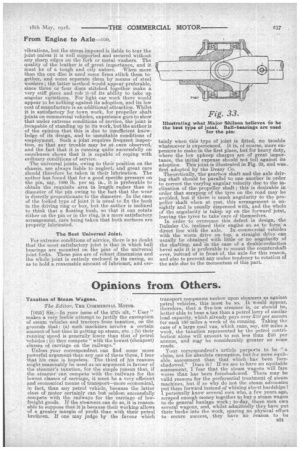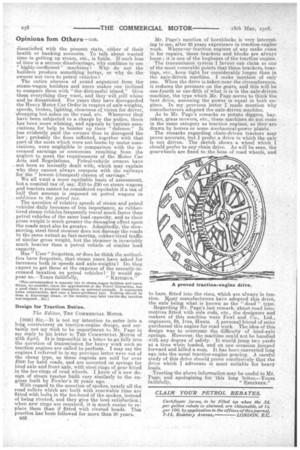Opinions from Others.
Page 15

Page 16

If you've noticed an error in this article please click here to report it so we can fix it.
Taxation of Stearn Wagons,
The Editor, TEE COMMERCIAL MOTOR.
[1625] Sir,—In your issue of the 27th ult, " User " makes a very feeble attempt to justify the. exemption of steam vehicles and tractors from taxation, on the grounds that: (a) such machines involve a certain amount of lost time in getting up steam, etc. ; (b) their running speed is generally lower than that of petrol vehicles ; (c) they compete with the lowest (cheapest) .classes of carriage on the railways."
Unless your correspondent can find some more powerful argument than any one of these three, I fear that his case is hopeless. The third of his reasons might reasonably be used as an argument in favour of the steamer's taxation, for the simple reason that, if the steamer can compete with the railways for the lowest classes of carriage', it must be a very efficient and economical means of transport—more economical, in fact, than any petrol vehicle, because the .latter class of motor certainly can but seldom successfully compete with the railways for the carriage of lowfreight goods. If the steamers can do so, it is reasonable to suppose that it is because their working allows of a greater margin of profit than with their petrol brethren. If one may judge by the favour which transport companies bestow upon steamers as against petrol vehicles, this must be so. It would appear, therefore, that a five-ton steamer is, or should be, better able to bear a, tax than a petrol lorry of similar load capacity, which already pays over 210 per annum for each 100 miles a week of its running. Taking the case of a large mail van, which runs, say, 400 miles a week, the taxation represented by the petrol contribution alone will amount to not less than 240 per annum, and may be considerably greater on some roads.
Your correspondent's article pueperts to be "a claim, not for absolute exemption, but for more equitable assessment than that which has been foreshadowed." Does it'? If we are to have an equitable assessment, I fear that the steam -wagons will fare worse than has been foreshadowed. There may be valid reasons for the preferential treatment of steam machines, but if so why do not the steam advocates put them forward instead of whining about hardships? I personally know several men who, a few years ago, scraped enough money together to buy a steam wagon to do general haulage work ; to-day, those men own several wagons, and, whilst admittedly they have put their backs into the work, sparing no physical effort to secure success, they have no reason to be dissatisfied with the present state, either of their health or banking accounts. To talk about wasted time in getting up steam, etc., is futile. If such loss of time is a serious disadvantage, why continue to use "highly-inefficient" machines 1 Why do not the builders produce something better, or why, do the owners not tura to petrol vehicles.?
The entire absence of sound argument from the steam-wagon builders and users makes one inclined to compare them with "the distrassful island." Give them everything they want, and they will still whine and be dissatisfied. For years they have disregarded the Heavy Motor Car Order in respect of axle-weights, speeds, brakes, lighting, clearness ot vision for driver, ' dropping hot ashes, on the road, etc. Whenever they have been subjected to a charge by the police, there has been more whining, and appeals to various associations for help to bolster up their "defence." It has evidently paid. the. owners thus to disregard the law' probably the fines inflicted, together with that part of the oosts, which were not borne by motor associations, were negligible in comparison with the increased earnings or economies resulting from the neglect to meet the requirements of the Motor Car Acts and Regulations. Petrol-vehicle owners have not been so leniently dealt with, which may explain why they cannot always compete with the railways for the lowest (cheapest) classes of carriage." We all want a more equitable basis of assessment, but a nominal tax of, say, £10 to 220 on steam wagons and tractors cannot be considered equitable if a tax of half that amount is imposed on petrol wagons in addition to the petrol tax.
The question of relative speeds of steam and petrol vehicles daily becomes of less importance, as rubbertired steam vehicles frequently travel much faster than . petrol vehicles of the same load capacity, and as their gross weight is much greater the damaging effect upon the roads must also be greater. Admittedly:the slowmoving, steel-tired steamer does not damage the roads to the same extent as fast-moving, rubber-tired traffic of similar gross weight, but the steamer is invariably much heavier than a petrol vehicle of similar load capacity.
Has User" forgotten, or does he think the authorities have forgotten, that steam users have asked for increases both in speeds and axle-weights ? Do they expert to get these at the expense of the recently-increased taxation on petrol vehicles ? It would ap
pear so.—Yours faithfully, " KRITIKUS."
[This correspondent is scarcely fair to steam-wagon builders and users. Steam, we consider, since the appointment of the Petrol Committee, has a good claim to practical exemption on national grounds. It represents home construction, and uses a home-produced fuel. Nothing should be done to discourage steam, or the country may later rue the day taxation was imposed—En.]
Design for Traction Duties.
The Editor, THE COMMERCIAL MoToit.
[1626] Sir,—It is not iny intention to . enter into a long controversy on traction-engine design, and certainly not my wish to be itnpertinent to Mr. Page in my reply to his letter in Tun COMME,RCIAL MOTOR of 27th April. It is impoissible in a letter to go fully into the question of transmission for heavy work such as traction engines are called to perform. I may say the engines I referred to in my previous letter were not of the cheap type, as these engines are sold for over D300 for hard roads, and are mounted on springs for hind axle and front axle, with steel rings of gear fitted
• in the tee-rings of road wheels. I know of a new design of steam tRactor built very similarly to the engines built by Fowler's DO years ago.
• With regard to the question of spokes, nearly all the road rollers which are built with renewable rims are fitted with bolts in the tee-head of the spokes, instead of being riveted, and they give the best satisfaction ; when new rings are required, it is much easier to replace them than if fitted with riveted heads. This , practice has been followed for more than 20 years.
B52
Mr, Page's mention of hornblacks is very intere.sting to me, after 26 years experience in traction-engine work. Whenever traction engines of any make come in for repairs, these brackets and blocks are always loose ; it is one of the bugbears of the traction engine.
The transmission system I favour can claim as one • of the most venerable points that these brackets, bearings, etc., -keep tight for considerably longer than in the axle-driven machine. I make mention of only one. When the drive istaken near the circumference, it reduces the pressure on the 5ears, and this will be one-fourth or one-fifth of what it is in the axle-driven machine, the type which Mr. Page seems to think the best drive, assuming the power is equal in both engines. In my previous letter I made mention why manufacturers adopted the axle-driven machine. As to Mr. Page's remarks re potato diggers, hayrakes, grass mowers, etc., these machines do not come in the same category as traction engines, as they are drawn by horses or some mechanical-power plants.
The remarks regarding chain-driven tractors may prove accurate, 'but I prefer a drive in which the axle is not driven. The sketch shows a wheel which I should prefer to any chain drive. As will be seen, the gearwheels are fixed to the boss of road wheel's, and to bars, fitted into the rims, which are always in tension. Aany manufacturers have adopted this drive, the axle being what is known as the " dead " type.
Regarding Mr. Page's last remark, about road locomotives. fitted with side rods, etc., the designers and makers of this machine were Fowl and Co., Ltd., engineers, St. Ives, Hunts. A personallriend of mine purchased this engine for road work. The idea of this design was to overcome the difficulty of hind-axle springs. However, the machine could. not be handled with any degree of safety. It would jump two yards at a time when loaded, and on one occasion jumped forward and killed a man. It has been converted long ago into the usual traction-engine gearing. A careful study of this drive should prove conclusively that the drive which I advocate is most suitable for heavy loads.
Trusting the above information may be useful to Mr. Page, and apologizing for, this long letter,—Yours
faithfully, "ENGINEER."




















